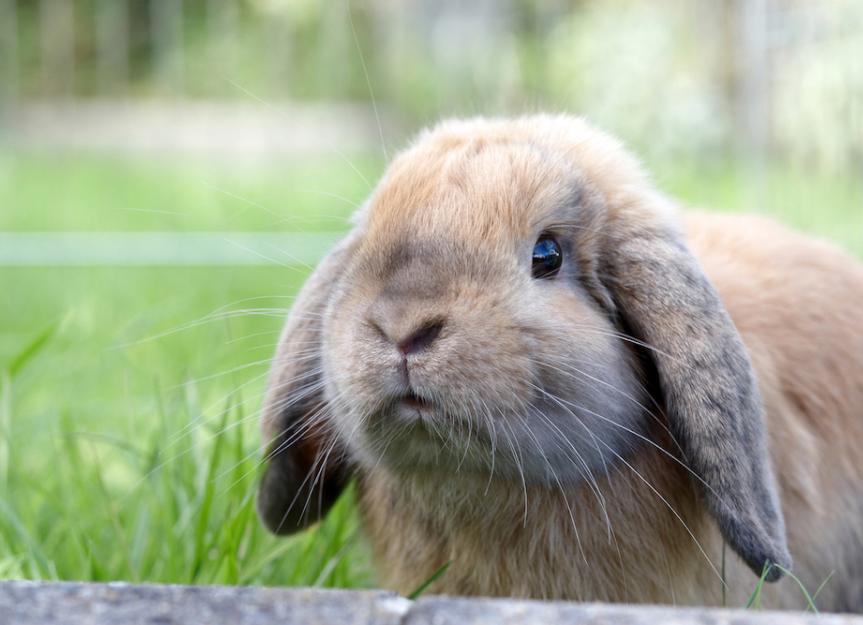Pododermatitis in Rabbits
What is Pododermatitis in Rabbits?
Pododermatitis means inflammation of the feet. This is a fairly common condition in rabbits at any age or gender, so it is essential to know what signs to watch out for and what preventative measures you can take to prevent it.
Unlike cats, dogs, and humans, rabbits do not have a foot pad or thick musculature on their feet and hock/ankle bottoms. They have very thick fur over thin skin to protect and cushion the feet. If that fur is compromised or lost, without the thick cushion that the fur provides, excessive pressure on the underlying skin can become inflamed. Without any intervention, continued pressure and friction can cause ulcers and infection, and it can cause a lack of blood flow to the area resulting in tissue death or necrosis.
Anything that causes excessive pressure, shearing forces, friction, and moisture can cause pressure sores in people and rabbits, especially on the bottoms of their feet. Some rabbit breeds are more likely to get pododermatitis, like the short-coated Rex breeds because the fur is already thin on their feet, or large giant breed rabbits because they have extra pressure and weight placed on their feet. Rabbits that also love to thump or slap their back feet on the ground can be at risk for developing pododermatitis down the road due to this behavior.
Pododermatitis is commonly called ulcerative pododermatitis because it often causes tiny surface ulcers as part of the disease process. Sore hocks is also a common term for the condition because it often causes inflammation of the rabbit's feet and hock or ankle. Bumblefoot is commonly used in birds but can also be referred to in rabbits.
Symptoms of Pododermatitis in Rabbits
皮肤会变红时,皮毛是丢失或thinned on the bottom of the feet and hock. This can progress to ulcers (open sores). Eventually the open sores can become infected. If left untreated for too long, the feet can bleed, and rabbits can become anemic from the blood loss. The infection can progress into septicemia, the clinical name for blood poisoning by bacteria. Without treatment, this can be fatal to rabbits.
This entire process is very painful. Rabbits in pain will often eat less, grind their teeth or bruxism, defecate less, and can go into gastrointestinal stasis. Rabbits in pain will often sit in a hunched posture, close their eyes tightly, flatten their cheeks, ears down and held back, and whiskers are held horizontally and pulled close to their cheeks. Early signs of pododermatitis include:
Fur loss on bottoms of feet and hocks
Red skin on bottoms of feet and hocks
Swelling of feet
Pain
Shallow ulcers or open sores
Severe signs include:
Abscesses
Gastrointestinal stasis
Blood loss and anemia
Infection and septicemia
Osteomyelitis or infection of the bone
Erosion of bone and ligaments
Rupture of the superficial digital flexor tendon leading to impaired extension of the hock or ankle and a permanently disabled rabbit
Death
Causes of Pododermatitis in Rabbits
There are many causes of pododermatitis in rabbits. Anything that leads to inactivity and increased pressure/trauma on the skin of the feet can lead to sore hocks. When too much pressure is placed on the thin skin of the feet, it compresses that tissue leading to ulcers, inflammation, and skin death or necrosis. The ulcers can worsen and cause significant bleeding and anemia or a decrease in the total red blood cells in the body. Advanced cases can cause the superficial flexor tendon in the foot to become displaced/ruptured, which can cause a permanent change to the hindfoot conformation. The toes cannot flex, which leads to extra weight being put on the point of the hock and permanent disability.
Any of the following can put your rabbit at risk for pododermatitis:
Hard surfaces or flooring that prevent the back feet from resting normally such as wirecagebottoms or hardwood
Obesity
Pregnancy
Lack of mobility due to a small cage or lack of exercise
Large or giant breed rabbits have more weight/pressure placed on their feet, so they are at greater risk
Lack of fur on the bottoms of the feet from wear or clipping
Poor nutrition
Moist and unhygienic conditions aggravate this disease such as urinary and fecal soiling and not cleaning the bedding daily
Lameness on any foot leading to excessive pressure on other feet
Loss of limbs/paralysis/paresis
Certain breeds like Rex have fine, sparse hair making them more predisposed
Abrasive surfaces like carpets can produce friction on the skin
Spinal deformities
How Veterinarians Diagnose Pododermatitis in Rabbits
Diagnosis is typically made through history and physical examination. With more chronic or severe cases, radiographs/x-rays and bloodwork are often performed to characterize the disease's progress further.
For aphysical exam, the limbs and digits will be thoroughly evaluated, and the gait and stance of your rabbit will be assessed.
Complete blood counttests will look at the red blood cells, white blood cells, and platelets. These tests are used to assess for anemia or low red blood cells and infection with elevated white blood cells.
Chemistryis bloodwork used to evaluate the kidney values, liver values, and electrolytes to look for any underlying disease that could contribute to pododermatitis or exacerbate it.
X-rayscan look for osteomyelitis or infection of the bones in the feet, as well as evaluate the spine for any spinal deformities which can contribute to pododermatitis.
Culture and sensitivitytests involve a swab used to take samples of any abscesses or ulcers which are sent to a lab that grows the sample on a culture disc, evaluates if any bacteria is growing and causing infection, and then tests the bacteria against antibiotics to figure out which antibiotic would be best for treatment of the infection.
Treatment of Pododermatitis in Rabbits
The best thing you can do at home for rabbits diagnosed with pododermatitis is to remove any cause of the issue. Always consult your veterinarian on any changes you plan to make. Some options include softer flooring like:
Thick yoga mats
Foam egg crates used for bed
Lots of towels
Lots ofpaper bedding
Deep layer of peat moss
Encourage any overweight rabbits to exercise. Arunplaced on a dry grassy lawn is an excellent surface for rabbits to play on as long as it is clean, free of wild rabbits, and your rabbit is protected against fleas and mosquitos. Make sure to change the bedding daily and keep your rabbit’s feet clean and dry. Providing daily exercise permitting your rabbit’s pain to be controlled.
Pododermatitis is often progressive and cannot be reversed, so it isn’t easy to treat. If your rabbit has severe chronic pododermatitis and is painful, your veterinarian may recommend euthanasia if management cannot be achieved.
Your veterinarian might recommend liquid bandages, boots, or removable bandages to protect the feet. Please remove and change any soiled bandages immediately and follow your veterinarian's instructions on all recommendations. Your veterinarian may also recommend:
Systemic antibiotics if the wound is infected
Topical ointments like manuka honey can be used for inflammation and infection
疼痛的止痛剂使兔子帽re mobile
Surgery is sometimes recommended if the pododermatitis is severe to provide a new skin flap to cover the ulcers
Recovery and Management of Pododermatitis in Rabbits
Under the guidance of your veterinarian, some management strategies include:
Thick bedding of straw or hay, absorbent bedding where the rabbits spend the most time
Eliminate wire flooring and concrete
Weight reduction or weight gain based on body condition
Protective boots, if needed
Pododermatitis may also lead to:
Septicemia: blood poisoning by bacteria
Osteomyelitis: infection of the underlying bone
Displacement of tendons causing permanent disability and paralysis
Ear infections: Rabbits use their hind limbs to clean their ears, so it is essential to monitor their ears and clean them regularly
Prevention of Pododermatitis in Rabbits
The best way to prevent pododermatitis is with proper care and diet, preventing your rabbit from becoming overweight, encouraging daily exercise (ideally 4 hours a day), and keeping your rabbit in a large enclosure. It is essential to clean the cage daily and always keep your rabbit on soft flooring. Yearly veterinary examinations are highly recommended.
A good rule of thumb to judge the size of your rabbit’s cage is to provide a space that is at least four times the size of your rabbit. Your rabbit should be able to hop around and stand on its hind legs without touching the top of the enclosure. But the bigger, the better! And if you can provide them with a permanently attached exercise area of about 24 square feet, it is ideal to place thick yoga mats or nonabrasive carpets inside the exercise area.
References
Harcourt-Brown, Frances. Textbook of Rabbit Medicine. United Kingdom, Butterworth-Heinemann, 2002.
Quesenberry凯瑟琳和詹姆斯·w·木匠。菲rrets, Rabbits, and Rodents-E-Book: Clinical Medicine and Surgery. Elsevier Health Sciences, 2020.
Jörg Mayer, Donnelly TM. Clinical Veterinary Advisor. Birds and Exotic Pets. Elsevier/Saunders; 2013.
菲atured Image: iStock.com/tirc83

